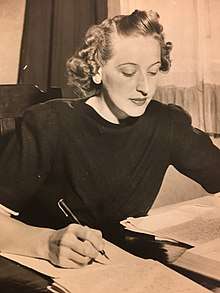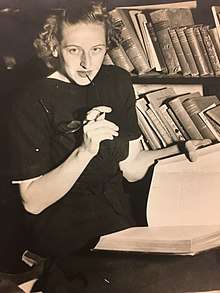June Wright
Dorothy June Wright (née Healy; 29 June 1919 – 4 February 2012) was an Australian writer. She wrote six popular crime novels between 1948 and 1966, all with recognisable settings in and around Melbourne. She also wrote many articles for Catholic lay journals such as The Majellan, Caritas and Scapular and the Catholic newspaper The Advocate. She recorded her personal memoirs and family history in two volumes in 1994 and 1997.[1]
June Wright | |
|---|---|
 June Wright at work, 1952 | |
| Born | Dorothy June Healy 29 June 1919 Malvern, Victoria |
| Died | 4 February 2012 (aged 92) |
| Nationality | Australian |
| Occupation | writer |
| Years active | 1948-1997 |
| Spouse(s) | Stewart Wright |
| Children |
|
Early life and education
Wright was born in 1919 in Malvern, Victoria and educated at Malvern's Kildara College, Loreto Mandeville Hall, in Toorak. After leaving school, she briefly studied commercial art at Melbourne Technical School before working as a telephonist at the Central Telephone Exchange in Lonsdale Street, Melbourne, which formed the basis of her first novel Murder in the Telephone Exchange.[2] In 1941 she married Stewart Wright, an accountant. They had six children: Patrick, Rosemary, Nicholas, Anthony, Brenda and Stephen.[3]
Bibliography
Novels
- June Wright (1948). Murder in the Telephone Exchange. Hutchinson and Co. Publishers Ltd (Sydney). (Reprinted June Wright (2014). Murder in the Telephone Exchange. Verse Chorus Press (Portland, Oregon). ISBN 978-1-891241-37-6. Introduction by Derham Groves.)
- June Wright (1949). So Bad a Death. Hutchinson and Co. Publishers Ltd (Sydney). (original title, vetoed by Wright's publisher, Who Would Murder a Baby?) (Reprinted June Wright (2015). So Bad a Death. Verse Chorus Press (Portland, Oregon). ISBN 978-1-891241-45-1. Introduction by Lucy Sussex.)
- June Wright (1953). The Devil's Caress. Hutchinson and Co. Publishers Ltd (Sydney) Verse Chorus Press. (Reprinted June Wright (2018). The Devil's Caress. Verse Chorus Press (Portland, Oregon). ISBN 978-1-891241-43-7. Introduction by Wendy Lewis.)
- June Wright (1958). Reservation for Murder. John Long, London. (Reprinted June Wright (1970). Reservation for Murder. Fleetways Library, Black Tulip Thriller Romances No 23.)
- June Wright (1961). Faculty of Murder. John Long, London.
- June Wright (1966). Make-up for Murder. John Long, London.
- June Wright (2015). Duck Season Death. Verse Chorus Press. ISBN 978-1-891241-35-2. Introduction by Derham Groves (previously unpublished).

Short stories
- June Wright (1954). Mother Paul Investigates.
Non-fiction writings
- June Wright (1994). The Eagle and the Stag. ISBN 0-646-235-710. An account of the results of June's researches of her forebears.
- June Wright (1997). Remembering Melbourne. ISBN 0-646-316-001. A personal memo.
Collections of writings
- Wright, Patrick (2014). The Collected Works of June Wright: Volume 1 & 2 Crime Fiction. ISBN 978-0-9924729-0-0. Melbourne: The Estate of Dorothy June Wright (hardback)
- Wright, Patrick (2014). The Collected Works of June Wright: Volume 3-5, Non-Fiction. ISBN 978-0-9924729-1-7. Melbourne: The Estate of Dorothy June Wright (hardback)
Adaptations
June Wright's novel, The Devil's Caress was adapted for stage by Wendy Lewis and premiered in Sydney in March 2018.[4]
June Wright in popular culture
Wright's work featured in the Baillieu Library Exhibition, Murderous Melbourne: A Celebration of Australian Crime Fiction and Place, The University of Melbourne (10 June to 7 September 2008). The exhibition involved architecture students designing new dust jackets for Wright's book Faculty of Murder.[5]
Her books also feature in Highlights and Lowlifes (29 June to 31 August 2015), an exhibition on the Holdings in the Australian Detective Fiction Collection at Fisher Library, The University of Sydney which showcased 19th century crime writers such as Fergus Hume (“Mystery of a Hansom Cab”); the early Boney novels of Arthur Upfield; and Australia's under recognised female crime writers such as Ellen Davitt and Mary Fortune through to the 20th century's Pat Flower, Pat Carlon, Margot Neville and June Wright.[6]
References
- Wright, Patrick. The Collected Works of June Wright: Volume 2, Crime Fiction. p. 551.
- Groves, Derham; Wright, Patrick (19 March 2012). "Juggled crime fiction with motherhood". Sydney Morning Herald.
- June Wright, The Age, 19 March 2012.
- "'Devil's Caress' By Playwright Wendy Lewis". Sydney Arts Guide. 28 March 2018.
- Groves, Derham; Krautschneider, Astrid Britt; Saniga, Andrew; University of Melbourne. Information Services; University of Melbourne. Faculty of Architecture, Building & Planning (2008), Murderous Melbourne : a celebration of Australian crime fiction and place, University of Melbourne, ISBN 978-0-7340-3978-1
- Ferro, Katarina. "Exhibition: Highlights and Lowlifes – 29 June to 31 August".